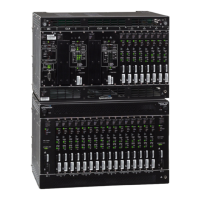74 TimeHub 5500 User’s Guide 097-55501-01 Revision M – January 2009
Chapter 2 Engineering Ordering Information
NTP Server Card
The Management Port:
The Ethernet port on the NTP Connector card is not for general use at this time.
It is currently only used for downloading software to the NTP card.
The NTP card is managed via the IMC using either the Ethernet or RS-232 port
on the TimeHub Master shelf.
Local NTP System Clock and Hardware Timestamp
The NTP system clock of the NTP card is driven by the 125 MHz frequency signal,
which gives the NTP system clock a resolution of 8 nanoseconds (1/125 MHz). The
hardware timestamp is much more accurate than software timestamp because
hardware timestamp mechanism is precise and repeatable.
How the local NTP system clock keeps its accuracy depends on its stratum level.
Primary Server
When a TimeHub system has access to stratum 0 TOD source (time code and 1
PPS from TimeSource or GPS), the NTP card is configured as a primary NTP
server. The stratum 0 time code data is loaded into the local NTP system clock at a
rate of once a second, using the 1 PPS signal.
The local NTP system clock is driven by 125 MHz clock which is derived from highly
stable precision TimeHub clock. The time error in 1 second is much smaller than 1
ns. The GPS 1 PPS time tick has an accuracy of a few tens of nanoseconds, and
this makes the time accuracy of the NTP system clock a few tens of nanoseconds.
Secondary Server
When a TimeHub system does not have access to stratum 0 TOD input, the NTP
card must be configured as a secondary NTP server. In this case the NTP card
needs to get TOD data from external stratum 1 or 2 (peer) NTP servers. The
standard NTP software package on the TimeHub NTP Server card uses the
timestamps received from external peer NTP servers to calculate the offset between
the local TimeHub NTP system clock and the peer NTP server clocks. This offset is
used to correct the TimeHub NTP system clock at a rate of once a second.
NTP Card Clock Quality and Holdover
The NTP Server card has the following frequency and time inputs:
1.544 MHz from two Clock cards, via the backplane
1.544 MHz passthrough clock from the IMC card, via the backplane
TOD signal from TimeSource, via the connector card and the backplane
One of the three 1.544 MHz clock signals is selected and used as a reference to
generate the 125 MHz NTP system clock used throughout the card.

